Walking the Freedom Trail in St. Augustine will take you back to a time, where nothing came easy, where no right was a given, and where courageous people stepped into their roles as leaders of a movement.
Read the full story about the St. Augustine Freedom Trail at the St. Augustine News Connection. The civil rights movement in St. Augustine did not just happen. It did not happen overnight, and many of the people we now consider to be pivotal to the desegregation of St. Augustine found themselves to be in the center of the fight not because they wanted to be, but because they found it impossible not to be.
The Civil Rights Movement in St. Augustine played an important role in the passing of the Civil Rights Act of 1964.
 |
| The Civil Rights House 160 M.L.K. Avenue, St. Augustine, Florida The Freedom Trail - home of Dr. Robert B. Hayling. |
The Civil Rights House
160 M.L.K. Avenue, St. Augustine, Florida
The Freedom Trail marker inscription:
"The southern half of Lincolnville was, in colonial times, a plantation called "Buena Esperanza" (Spanish for "Good Hope"). During the Flagler Era of the 1880s, it was bought by Standard Oil millionaire William Warden and developed as a residential subdivision. One of Warden's investments was the local gas and electric company, whose manager lived in this elegant Victorian house, which originally bore the address of 160 Central Avenue.In 1954, the U. S. Supreme Court ruled in the famous case of Brown v. Board of Education that racially segregated schools had to end. This was a harbinger for the end of the Jim Crow system of discrimination that had prevailed since the end of Reconstruction. Most of the southern states responded by establishing some kind of official state commission to see what could be done to preserve racial segregation as long as possible. Florida's contribution to that was called the Fabisinski Committee, headed by Judge L. L. Fabisinski--who had grown up here in this house in the early years of the twentieth century. Five decades after Judge Fabisinski left, this house became, in 1964, the home of Dr. Robert B. Hayling, the courageous dentist who was the main organizer of the civil rights movement in St. Augustine. For his outstanding leadership, Dr. Hayling has been hailed as "The Father of the Civil Rights Act of 1964."There is no other house in St. Augustine--probably no other house in America--that within its walls has sheltered the two opposite sides of that great conflict that shaped our modern democracy. Thus, it is known as "The Civil Rights House."
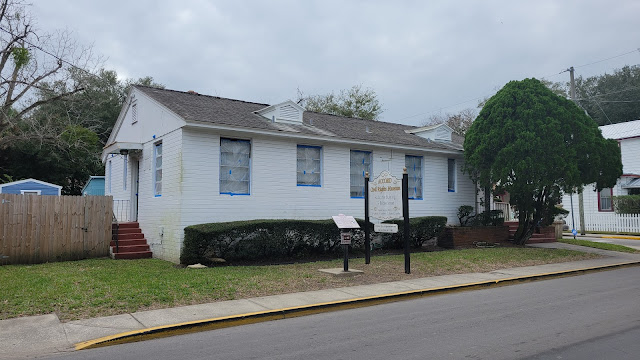 |
| The Accord Museum St. Augustine Dr. Hayling's Dental Office in Lincolnville |
Dr. Hayling's Dental Office in Lincolnville
79 Bridge Street
(Now the Accord Civil Right's Museum in St. Augustine, Florida)
The Freedom Trail Marker inscription:
"The Rudcarlie Building at 79 Bridge Street was built in the 1950's by Dr. Rudolph N. Gordon (1901-1959) and named for the members of his family. Rudolph, Carlotta, and Rosalie. It was the first medical/dental office constructed in St. Augustine without racially segregated waiting rooms.After Dr. Gordon's death, the office was rented to Dr. Robert B. Hayling, a dentist who became a prominent leader of the civil rights movement in St. Augustine. Many of the planning sessions for the movement were held here, with Dr. Martin Luther King, Jr. and others. On one occasion, the owner of a local tourist attraction came to the office with a gun and said he intended to kill Dr. King, "but I can't do it, because when I look at you, I see that you are a God-sent man." Lawyers who came to support the civil rights efforts made this building their headquarters as well. Two of them--Alvin J. Bronstein and Ralph Temple--were honored by ACCORD when they returned to the Ancient City in 2005.Dr. Gordon's widow, Mrs. Rosalie Gordon-Mills (1907-2004) made history in 1965 when she became the first black woman in 400 years to seek public office."
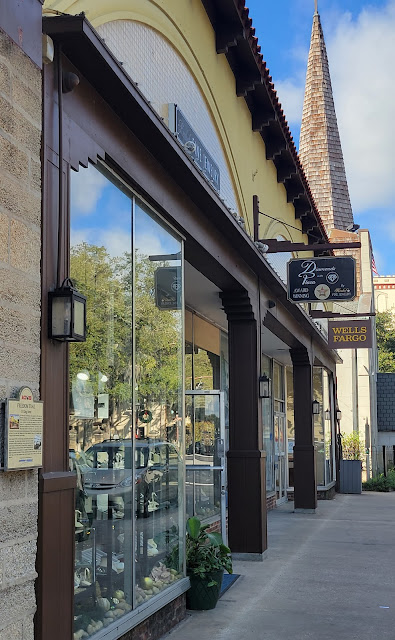 |
| The former Woolworth's store in St. Augustine |
Woolworth's
31 King Street, St. Augustine
The Freedom Trail marker inscription:
"The Ponce de Leon Shopping Center opened in 1955 as the first downtown shopping center in St. Augustine. It was designed by Morris Lapidus (1902-2001), Florida's most famous mid-twentieth century architect, and is the only example of his work in the Ancient City. It was anchored by a Woolworth's store on the west side (the door handles still say Woolworth's). On February 1, 1960, black college students in Greensboro, N.C. began a sit-in at their Woolworth's lunch counter to protest racial discrimination. Their example electrified the south, and just a few weeks later, students from Florida Memorial College in St. Augustine began sitting-in at this Woolworth's lunch counter.In the summer of 1963, local black high school students sat-in here and were arrested. They refused when the judge wanted them to end their participation in the civil rights effort, and as a result spent the next six months in jail and reform school. The case of the St. Augustine Four--Audrey Nell Edwards, JoeAnn Anderson, Samuel White and Willie Carl Singleton--received national publicity as an example of injustice, and finally the governor and cabinet of Florida ordered them released in January 1964. Dr. Martin Luther King, Jr. and Jackie Robinson hailed the St. Augustine Four as heroes of the civil rights movement."
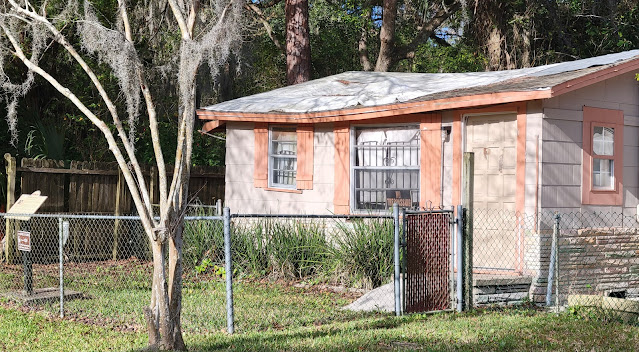 |
| 1074 West King Street, St. Augustine, Florida |
Home of Mrs. Georgie Mae Reed
1074 West King Street, West Augustine, Florida
The Freedom Trail marker inscription:
"This was the home of Mrs. Georgie Mae Reed (1926-1995), who took part in one of the most famous events in the civil rights movement that changed America and inspired the world. On March 31, 1964, Mrs. Reed was one of five St. Augustine women who accompanied Mrs. Mary Peabody, the 72 year old mother of the governor of Massachusetts, to the Ponce de Leon Motor Lodge on U.S. 1 North.
The group sat down in the restaurant there and asked to be served. They were arrested instead. That event was reported on the front page of newspapers around the country, and from that point on, international attention was focused on the activities in St. Augustine that led directly to the passage of the landmark Civil Rights Act of 1964. Mrs. Reed suffered from polio, but she did not allow that to stop her on the day that she put on her Sunday best and walked off into American history. She told her story to Pulitzer Prize-winning author Taylor Branch when he was in St. Augustine in 1991, but did not live long enough to see his book Pillar of Fire (1998) in which her heroism was celebrated."
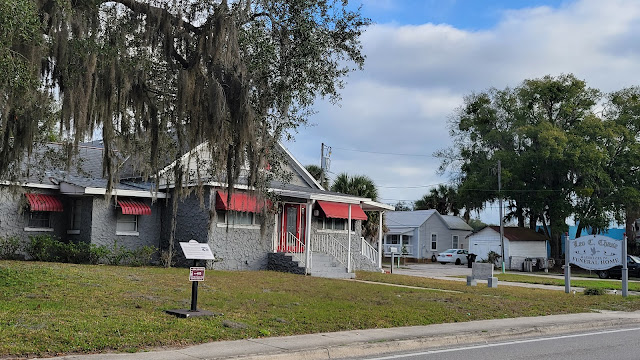 |
| Leo C. Chase Funeral Home on West King Street |
Leo C. Chase Funeral Home
262 West King Street, St. Augustine, Florida
The Freedom Trail marker inscription:
"Leo C. Chase, Sr., who had previously managed the Huff Funeral Home in Lincolnville, opened one of the oldest businesses in St. Augustine, this funeral home in 1955. His son, Arnett Chase, took over after his father's death in 1977. Another son, Leo C. Chase, Jr., was the first St. Augustinian killed in the Vietnam War, and a nearby park was named in his honor in 1965.During the 1960s, this was a place of sanctuary for civil rights activists who were subjected to harassment in St. Augustine. The funeral home's ambulance was used to take marchers to the hospital when they were beaten in the downtown area. Dianne (Mrs. Arnett) Chase took part in the demonstrations that led to the passage of the landmark Civil Rights Act of 1964.There were many black elected officials in St. Augustine in the decades after the Civil War, but the shooting of black alderman John Papino by a white city marshal during an official meeting in 1902 was the act of terror that put an end to black political office holding for more than 70 years. Arnett Chase made history in 1973 when he was elected to the city commission as the first black elected official in modern times.In 2008, a Chase limousine went to the Jacksonville airport to pick up the Rev. Dr. C. T. Vivian, one of Dr. Martin Luther King's closest associates. Vivian returned to St. Augustine--where he had been beaten and arrested while leading beach wade-ins and demonstrations in 1964--to address the second annual Freedom Trail Banquet sponsored by ACCORD."
 |
| 256 MLK Avenue St. Augustine Freedom Trail Janie Price's Home |
Janie Price's Home
256 MLK Avenue St. Augustine, Florida
The Freedom Trail marker inscription:
"The house at 156 Central Avenue was built in the 1950's for Mrs. Janie Price, a nurse at Flagler Hospital. She had taken her nurse's training at Grady Hospital in Atlanta in the 1940s and while there had attended dances with students from Morehouse College--one of them a teenager named Martin Luther King, Jr.When Dr. King came to St. Augustine during the campaign that led to the passage of the landmark Civil Rights Act of 1964, this was one of the houses where he stayed. Mrs. Price remembered Dr. King and his colleague, Rev. Ralph Abernathy, eating breakfast here before going off to be arrested at the Monson Motor Lodge on the bay front--an event that made international news.In 1985 the name of Central Avenue was changed to honor Martin Luther King. Many cities have streets named for Dr. King, but this one is special because he actually stayed on it in the course of changing history."
 |
| First Baptist Church Lincolnville, St. Augustine, Florida. |
89 St. Francis Street, St. Augustine, Florida.
The inscription:
"Established in 1872 through the efforts of Mrs. Hannah Jordan, a devoutly Christian sojourner who, like its first pastor, Rev. Father C. Felder, believed in leading by the example of hard work. The church has flourished at this location—since 1884. After the fire of 1915, this building was erected.During the era of the 1960s and The Civil Rights Movement, the congregation and its pastor, Reverend J.H. McKissick, gave support which allowed mass meetings to be held, engaged the leadership of the N.A.A.C.P., and later, the S.C.L.C. including Dr. Martin Luther King, and the founding of the N.A.A.C.P. Youth Council to take the lead in the local movement. Gerald Eubanks, a local college student, was elected president of the council, and local dentist, Dr. R.B. Hayling, served as advisor. For these pioneering efforts this church is considered the Cradle of the Civil Rights Movement in St. Augustine."
 |
| St. Paul A.M.E. Church, Lincolnville, St. Augustine, Florida |
85 M.L.K Avenue, Lincolnville, St. Augustine, Florida
The historic marker inscription:
“According to HIS Divine Light. To Each Of Us, God Has Given A Talent; Some to Lead, Some to Follow, Some to Build!” In January 1904, plans were made to build the present church. Rev. E.F. Williams is remembered as architect and builder. He uttered these words at the groundbreaking: “Upon this spot God's church is built and the gates of hell shall not prevail against it.” Thus, the legacy continues: the great models of leaders, believers, and builders propelled this church into the center of the Civil Rights movement of the 1960s in St. Augustine. It was physically and spiritually appropriate to convene mass meetings here. This was the site of spirited speakers, prominent among them Dr. Martin Luther King, Jr., his colleagues Rev. Ralph W. Abernathy, Hosea Williams, and Rev. Andrew Young, Executive Director of the S.C.L.C. and Field Marshall Willie M. Bolden. Their fortuitous visit of 1964 fostered the passage of the Civil Rights Act. From these convenings of hopeful souls for civil equality could be heard exhalations of Christian yearnings, and serene echoes of “We Shall Over Come!”
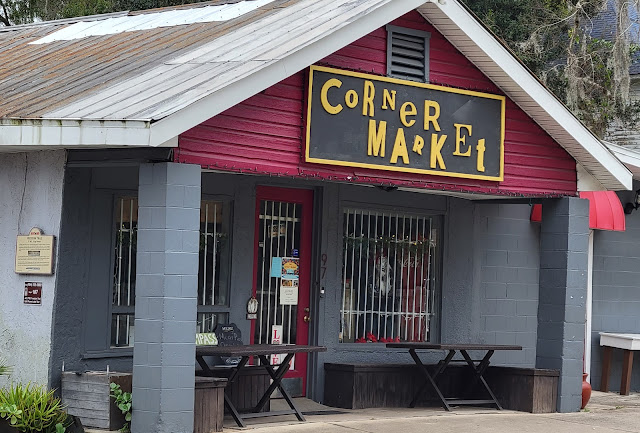 |
| The Corner Market in Lincolnville |
The Corner Market in Lincolnville
97 M.L.K. Avenue, St. Augustine, Florida
The Freedom Trail Marker inscription
"97 Martin Luther King Avenue was built in the 1920s by Frederick E. Martin, a prominent Lincolnville businessman whose name is set in the tile inside the front door. It was a popular confectionery and sundries store under many owners, drawing some of its customers from three neighboring schools: Excelsior, St. Benedict, and the Presbyterian Parochial and Industrial School.The back section of the building, along Dehaven Street, was added in the mid 1920s. It served first as a pool room, then as a barber shop. The Lincolnville Public Library, under the direction of Mrs. Dorcas B. Sanders, occupied the back section in the 1950s and 1960s.It was here that Rev. Thomas Wright, pastor of St. Mary's Baptist Church and president of the St. Augustine NAACP, trained students from Florida Memorial College in nonviolent techniques before they began sitting-in at local lunch counters in the 1960s to protest racial discrimination."
Read our articles on the efforts to save the Corner Market in Lincolnville here.
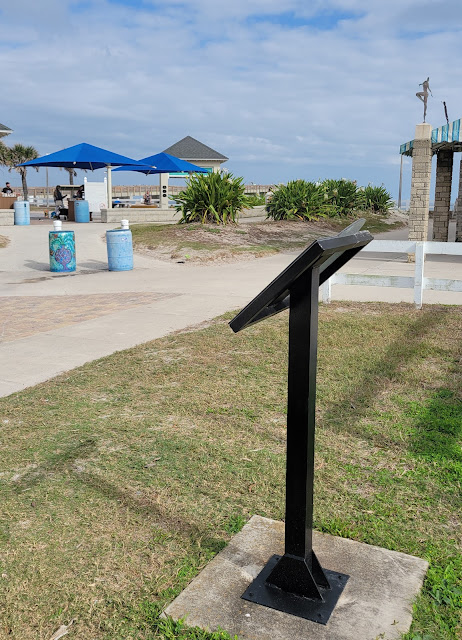 |
| St. Augustine Beach Wade-Ins Freedom Trail Marker |
St. Augustine Beach Wade-Ins Marker
350 A1A. St. Augustine Beach, Florida
(At the side of the parking lot by the St. Johns County Pier)
The Freedom Trail Marker inscription:
"Some of the most widely-publicized events of the civil rights movement took place at St. Augustine Beach in the summer of 1964, when wade-ins were conducted at what had historically been a beach reserved for “Whites Only”. Many courageous local residents took part in the wade-ins, along with a number of staff members of the Southern Christian Leadership Conference (SCLC), including Rev. C.T. Vivian, Rev. Fred Shuttlesworth, Dorothy Cotton, Al Lingo, Rev. LaVert Taylor, Benjamin Van Clarke, Golden Frinks, Rev. S. B. Wells, Dana Swan, Willie Bolden, and J. T. Johnson.Black and white supporters came from different parts of the country during a campaign organized by Dr. Robert B. Hayling that brought Dr. Martin Luther King, Jr. and SCLC to St. Augustine. The many rallies, marches, sit-ins, and wade-ins that took place here led directly to the passage and signing of the landmark Civil Rights Act of 1964 which outlawed racial segregation in hotels, motels, restaurants and other public accommodations, and job discrimination against blacks and women. Images broadcast internationally, of peaceful demonstrators being"
 |
| The Foot Soldiers Monument at Plaza de la Constitution in front of the old Slave Market in St. Augustine Florida. |
After walking much of the Freedom Trail we ended up at The Foot Soldiers Monument in front of the Slave Market at Plaza de la Constitucion in downtown St. Augustine, and it was a good reminder for why we need to stand up for and remember those who fought the fight for us all to have the freedoms we have today.
The monument is created to represent an approximate demographic profile of the foot soldiers from the civil rights movement in St. Augustine including a Caucasian college student, and three African Americans: A male in his thirties, a female in her sixties and a 16-year-old female.
The inscription says:
"Dedicated to those who participated in the Civil Rights Movement of the 1960s in St. Augustine. They protested racial discrimination by marching, picketing, kneeling-in at churches, sitting-in at lunch counters, wading-in at beaches, attending rallies, raising money, preparing meals and providing safe haven. They persisted in the face of jailings, beatings, shootings, loss of employment, threats and other dangers. They were Foot Soldiers for Freedom and Justice whose efforts and example helped to pass the landmark Civil Rights Act of 1964. Their courage and heroism changed America and inspired the world."
It is so easy to forget how much work, sweat, tears, courage and fear that came before us, but if you walk the Freedom Trail, you get a glimpse into a part of history not depicted in the local newspapers at the time or in many history books. The above are just a few of the places on the Freedom Trail in St. Augustine. You might have seen them when you drive around town, or when you are out walking, but it is not until you visit several of the places on the Freedom Trail that the magnitude of the people's sacrifices truly come to view.
You can find more information about the Freedom Trail markers in St. Augustine on the Accord Museum website here, and you can find a map of the St. Augustine Freedom Trail Markers here, or you can go to Visitor Center at 10 S Castillo Dr. in St. Augustine by the parking garage to get a brochure.
*This piece was originally posted at the West Augustine News Connection on January 8, 2022.
If you are not already following the below pages on social media, please consider doing so to learn more about all of St. Augustine's history.
*This piece was originally posted on the West Augustine News Connection on December 16, 2021.
Find more pieces about the St. Augustine Civil Rights Movement here.
Please sign up for the St. Augustine Connection newsletter and follow the St. Augustine Connection on social media.
Following us will help us spread the word about the work we do so that we can help serve you better.
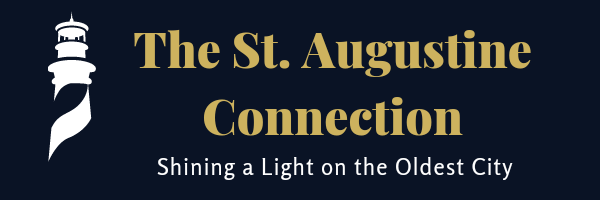

Comments
Post a Comment